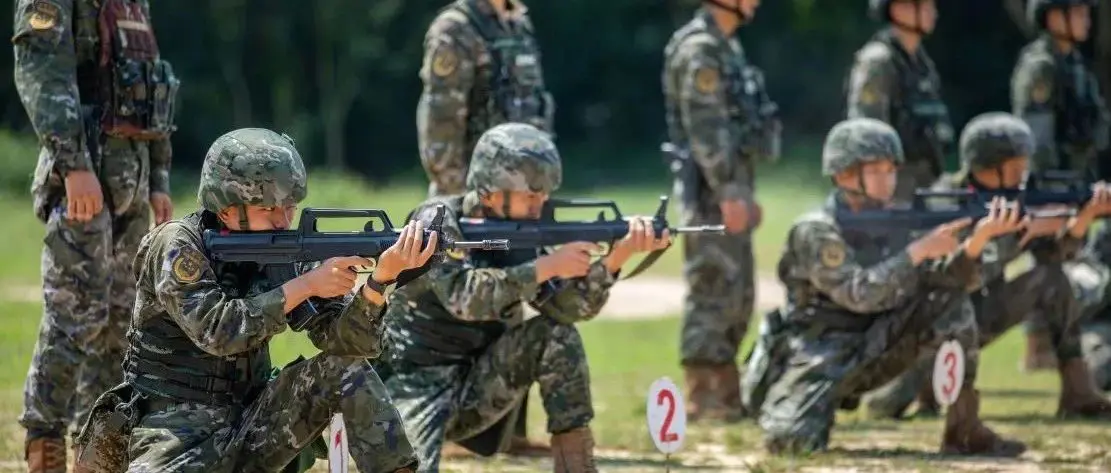Design of Field Shooting Training System for Medical Service Unit

**
**
Design of Field Shooting Training System for Medical Service Unit
Zhou Quan Niu Lu Li Weidong

【摘要】针对目前卫勤分队野外射击训练的问题和不足,基于神经网络和人工智能技术,设计一种卫勤分队野外射击训练系统。采用了一种通过神经网络深度学习目标检测算法和人工智能数据分析算法,基于低成本系统,通过系统功能设计和关键技术研究,分析系统通讯与数据安全,能源提供及便于携行。实现了将射击训练系统从传统的图像处理转向深度学习、从固定靶场转向野外实训、从大型电脑转向微型终端、从高成本转向低成本。为卫勤分队提供了一套能自动数据采集、提高射击精度、改进武器装备、快速装载展开的全天候低成本野外射击训练考核装置,能够有效提升卫勤分队射击训练水平。
【Keywords】Medical Support Unit|Field Shooting|Training System
Shooting training is a mandatory military training subject for all soldiers. Medical units, serving both as support and combat teams, also require essential shooting training. Currently, the field shooting training for medical units typically relies on fixed ranges and manual target reporting, which poses risks of casualties, inaccurate data, inconvenient recording, and the inability to correct shooting actions and essentials in real time. Some fixed ranges use automated target reporting systems, but these are expensive, complex to deploy, and limited to fixed locations, failing to meet the rapid deployment needs of medical units in field shooting training. Therefore, there is an urgent need for a field shooting system that can automatically report targets, record scores, analyze data, and quickly set up training for the practical training of medical units. This paper designs a field shooting training system for medical units based on a low-cost system using neural network deep learning target detection algorithms. Through system function design and key technology development, it provides a set of all-weather, low-cost field shooting training and assessment devices that can automatically collect data, improve shooting accuracy, enhance weaponry, and enable quick deployment.
1. System Design
1. Overall System Design
**
**
卫勤分队野外射击训练分析与考核系统是一套由采集终端、无线发射接收器、训练个人显示终端、训练集中显示终端、数据处理机、数据分析平台、装载携运箱等构成的一个自组网的完整运行系统。
(2) Introduction to Device Functions
**
**
采集终端:用于采集射击数据,通过图像采集的方式采集弹着点的图片信息,进行识别和计算,得到环数。带有灯光指示,方便夜间查看射击情况,具有一定的防弹功能。
无线发射接收器:在射击区和靶位区均设置了无线发射接收器,射击区发射接收器通过无线网络和训练个人显示终端连接,通过有线方式和训练集中显示终端、数据处理机连接,靶位区发射接收器通过无线网络和采集终端进行连接,从而完成组网功能连接所有设备。
训练个人显示终端:用于显示每个人每一次射击的情况,同时显示射击成绩以及语音提示射击偏差情况。
训练集中显示终端:用于显示所有的射击情况和射击成绩,同时通过此终端可对训练、人员、武器等进行管理。
Data Processing Machine: Used for the processing and analysis of shooting images, obtaining data such as the number of rings, scores, and deviations for each shooter, providing data for the data analysis platform.
Data Analysis Platform: Designed for managing and analyzing training sessions and individual performance, as well as analyzing data for each firearm, providing data support for scientific training.
Loading and Carrying Case: Designed with a universal military case set, it accommodates all equipment of this project, featuring strong shockproof, drop-proof, waterproof, and charging capabilities. It can be carried by one to two people, facilitating quick loading, deployment, and transportation.
(3) Introduction to System Function Analysis
**
**
The live-fire shooting training analysis system is a software management platform based on the equipment of this project, designed to manage and analyze each training session and each individual's training performance, as well as to analyze the data of each firearm. Therefore, it includes the following modules:
用户及权限管理模块:用于对训练人员身份、权限等属性的增删改查,具有导入、导出等基础功能,同时可以对个人信息进行脱敏处理。
Performance Management Module: Used to manage the performance of each trainee for every training session, which can be exported or displayed on the trainee's personal display terminal.
Training Management Module: Used for managing training plans, training content, training performance, training methods, and training outcomes.
Training Analysis Module: Designed to analyze and process various training dimensions such as individual training status, team training status, and continuous training status.
Equipment Management Module: Used for managing the usage of training equipment and ammunition, it can comprehensively analyze multi-dimensional information such as equipment, ammunition, shooting conditions, and shooters to obtain relevant data on the equipment.
2. Key Technologies of the System
The fundamental principle of the system is that the collection terminal gathers data and uses target detection methods to assess the shooting scores. This information is then transmitted to the command station via a wireless network, and after data analysis, it is further relayed to the shooting position.
Prediction of the target bounding box.
**
**
The network performs convolution predictions through (++) convolution kernels of a certain size in three feature maps, where is the number of preset bounding boxes (default value), and is the number of target categories to be predicted. Among these, parameters are responsible for predicting the offset of the target bounding box, parameters are responsible for predicting the probability of containing a target within the bounding box, and parameters are responsible for predicting the probability of this preset bounding box corresponding to target categories.
Figure: Schematic Diagram of Target Border Prediction Principle
The dashed rectangle in the figure represents the preset bounding box, and the solid rectangle represents the predicted bounding box calculated from the offset predicted by the network. We need to compute the final predicted target bounding box (,,,), and the transformation process from the preset bounding box to the final predicted bounding box is as shown in the formula:
bx=Cx+sigmoid(tx)
by=Cy+sigmoid(ty)
bw=Ph*sigmoid(tw)
bh=Pw*sigmoid(th)
Here, (,) are the center coordinates of the preset bounding box on the feature map, (,) are the width and height of the preset bounding box on the feature map, and (,,,) are the center offsets (,) and the width-height scaling ratios (,) predicted by the network for the bounding box. The function scales the predicted offsets to between and . Ultimately, we can obtain the final predicted target bounding box (,,,).
(2) Shooting Ring Number Recognition
**
**
Since the inception of deep learning object detection algorithms, they have opened the curtain for object detection. Subsequently, there have been iterations leading to various versions, each with distinct characteristics. Initially, only the last convolutional output layer was used for detection. However, small objects with fewer pixels would lose significant information through successive convolutions, making them difficult to recognize. The emergence of a new algorithm significantly improved the ability to detect small objects. Therefore, the system adopted this algorithm for bullet hole detection.
Deep learning frameworks prioritize the selection of frameworks, as they are dynamic frameworks with certain advantages in parameter adjustment compared to static frameworks. Therefore, the core computational software of the system is designed to determine the shooting score by detecting bullet holes and recognizing the corresponding target paper rings.
3. Communication and Data Security
The choice of communication depends on the computational capability of the collection terminal. When the collection terminal can meet the computational requirements, a narrow bandwidth communication mode is used. However, when the front-end computing power is insufficient and back-end computing is required, a wide bandwidth communication mode is adopted. To address the issue of instant image display, the system employs a wide bandwidth mode to ensure that each shooter can promptly see the details on the target paper, thereby correcting their shooting actions. Communication connections between the target position, shooting seat, and command seat are established via . or -. To ensure the security of data transmission and considering the classification level of the data and the computational consumption, it is planned to transmit the data after encryption.
4. Energy
As a condition for all-weather use, energy will be a critical issue that the system must face; without power support, everything comes to naught. Therefore, various energy-saving solutions have been adopted to address this problem.
(1) Collection Section
As much as possible, low-power computing chips should be used, and a series of chips paired with low-resolution display screens and intelligent screen control are planned to address the power issues of the acquisition terminals.
(2) Shooting Position Display Terminal
By employing a series of low-power technologies combined with an e-ink screen, it significantly reduces power consumption and enhances visibility under sunlight. Additionally, it incorporates lighting display to address the visibility issues during nighttime shooting training.
(3) Command Seat Display Terminal
As a display terminal, it also adopts a series of low-power chips, combined with a low-power screen to reduce power consumption.
(4) Data Processor
To further reduce power consumption, the data processor adopts series and cluster modes to address the issue of insufficient computing power, while also resolving the problem of high power consumption in the computing section.
5. Carry-on
Under all-weather conditions, carrying and transporting equipment is a significant challenge. All equipment in this system will be managed by two soldier-operable box units, utilizing wireless communication without the need for connecting cables. Both the collection terminal stand and the shooting seat display terminal stand are equipped with detachable quick-release stands. The command seat is designed with an integrated box unit, enabling rapid deployment and retraction, achieving immediate readiness for use, and allowing for quick transition into training mode and restoration to transport mode within minutes.
VI. Conclusion
This system boasts a high level of integration, simple operation, low material costs, and portability, making it particularly suitable for rapid deployment in field conditions. It addresses the challenges and shortcomings of field shooting training for medical teams. The next step involves accumulating a substantial dataset over a certain period of application to construct a more accurate mathematical model and establish a scientific training methodology. This will not only rapidly improve personnel training outcomes but also provide a scientific foundation for the enhancement of weaponry and shooting accuracy.
references
Chen Zaiwang, Wang Hong. Application of Single-Chip Microcomputer in Wireless Automatic Target Reporting System. Hardware Horizons, (): -.
林忠,罗德林,吕培聪.基于机器视觉技术的射击训练系统研究与设计.福建电脑,():-.
刘秋燕,陈耀武.基于视频图像分析的自动报靶方法研究.计算机工程,():-.
[4]Sumit A.Guthe Prof.P.Soni.Target Shooting Training and Instructive System Model using Python[J].International Journal of Engineering Research & Technology(IJERT),2016(5).
Li Ziyi, Yu Yang. A Vision Protection System Based on Deep Learning. Modern Computer, (): -.
Yuan Weiqi, Li Mengqi. Research on Automatic Target Reporting System for Chest Ring Targets Based on Visual Detection. Computer Technology and Development, (): -.
Editor of this issue: Chang Shaocheng
This issue reviewed by: Lin Yingxi
Layout Design: Zhou Kaikai
Article Source: "China Military-to-Civilian Magazine"
Collaboration Email: .
Submission email: .

